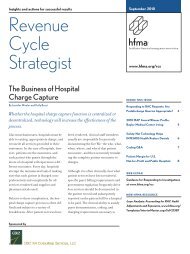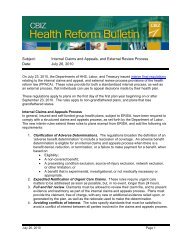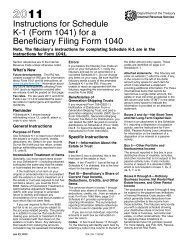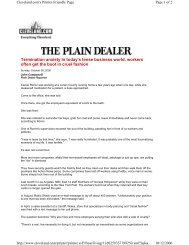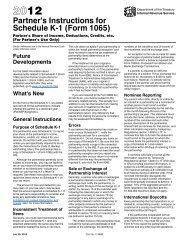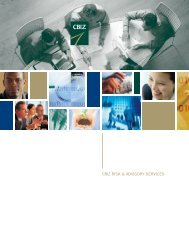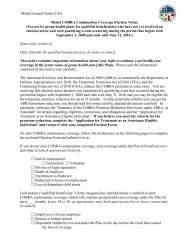IRS Publication 3998 (7-2002) - Employee Benefit Plans | 401k
IRS Publication 3998 (7-2002) - Employee Benefit Plans | 401k
IRS Publication 3998 (7-2002) - Employee Benefit Plans | 401k
Create successful ePaper yourself
Turn your PDF publications into a flip-book with our unique Google optimized e-Paper software.
CHOOSINGA RETIREMENT SOLUTIONfor Your Small Business
This pamphlet constitutes a small entity compliance guide forpurposes of the Small Business Regulatory EnforcementFairness Act of 1996. It does not constitute legal, accountingor other professional advice.Choosing A Retirement Solution for Your Small Business is a jointproject of the U.S. Department of Labor’s Pension and Welfare<strong>Benefit</strong>s Administration (PWBA), the Internal Revenue Service,the U.S. Small Business Administration, and the U.S. Chamber ofCommerce. Its publication does not imply endorsement of anycosponsor’s or participant’s opinions, products or services.This cosponsorship should not be construed either directly orindirectly as an endorsement or promotion of any products,services, activities or policies of any of the cosponsors by anyof the other cosponsors. The material in this brochure isdesigned to provide accurate and authoritative information inregard to the subject matter covered. It is distributed with theunderstanding that the publisher is not engaged in renderinglegal, accounting or other professional service. If legal adviceor other expert assistance is required, the services of a competentprofessional should be sought. The cosponsors make norepresentations or warranties regarding this publication and inno event shall the cosponsors be liable for damages, includingincidental or consequential damages, in connection with or arisingout of the performance or use of this publication.All programs of the Small Business Administration are providedto the public on a nondiscriminatory basis.For a complete list of PWBA publications, call toll-free:1-866-275-7922This material is also available to sensory impaired individualsupon request.Voice phone: 1-202-693-8664TDD phone: 1-202-501-3911This pamphlet is also available from the Internal RevenueService at (please indicate Catalog Number when ordering):1-800-TAX-FORM (1-800-829-3676)
Starting a small business retirement savingsplan can be easier than most businesspeople think. What’s more, there are anumber of retirement programs that providetax advantages to both employers andemployees.Why Save?Experts estimate that Americans will need 60 to 80 percent oftheir pre-retirement income – lower income earners may needup to 90 percent – to maintain their current standard of livingwhen they stop working. So, now is the time to look intoretirement plan programs. As an employer, you have animportant role to play in helping America’s workers save.By starting a retirement savings plan, you will help youremployees save for the future. Retirement plans may alsohelp you attract and retain qualified employees, and they offertax savings to your business. You will help secure your ownretirement as well. You can establish a plan even if you areself-employed. Better yet, you will join more than one millionsmall businesses with 100 or fewer employees that offerworkplace retirement savings plans.Any Tax Advantages?A retirement plan has significant tax advantages:●●●Contributions are deductible by the employer whencontributed;Employer and employee contributions are not taxeduntil distributed to the employee; andMoney in the retirement program grows tax-free.Any Other Incentives?In addition to helping your business, your employees andyourself, recent tax law changes have made it easier than everto establish a retirement plan. They include:●●●Higher contribution limits so youremployees (and you) can set asidelarger amounts for retirement;"Catch-up" rules that allow employees aged50 and over to set aside an additional $500(or $1,000, depending on the type of plan)for <strong>2002</strong>;Tax credit for small employers that wouldenable them to claim a tax credit for part ofthe ordinary and necessary costs of starting aSEP, SIMPLE, or certain other types of●plans (more on these later). The creditequals 50 percent of the cost to set up andadminister the plan, up to a maximum of$500 per year for each of the first 3 years ofthe plan; andTax credit for certain low- and moderateincomeindividuals (including selfemployed)who make contributions to theirplans ("Saver’s tax credit"). The amount ofthe credit is based on the contributionsparticipants make and their credit rate.The maximum contribution eligible for thecredit is $2,000. The credit rate can be aslow as 10 percent or as high as 50 percent,depending on the participant’s adjusted grossincome.A Few Retirement Plan FactsMost private-sector retirement vehicles are either IndividualRetirement Arrangements (IRAs), defined contribution (DC)plans, or defined benefit (DB) plans.An IRA is the most basic sort of retirement arrangement.People tend to think of an IRA as something that individualsestablish on their own, but an employer can help its employeesset up and fund their IRAs. With an IRA, the amountthat an individual receives at retirement depends on the fundingof the IRA and the earnings (or income) on those funds.Defined contribution plans are employer-established plansthat do not promise a specific amount of benefit at retirement.Instead, employees or their employer (or both) contributeto employees’ individual accounts under the plan,sometimes at a set rate (such as 5 percent of salary annually).At retirement, an employee receives the accumulated contributionsplus earnings (or minus losses) on such invested contributions.Defined benefit plans, on the other hand, promise a specifiedbenefit at retirement – for example, $1,000 a month at retirement.The amount of the benefit is often based on a set percentageof pay multiplied by the number of years the employeeworked for the employer offering the plan. Employer contributionsmust be sufficient to fund promised benefits.Small businesses may choose to offer IRAs, DC plans or DBplans. Many financial institutions and pension practitionersmake available one or more prototype retirement plans thathave been pre-approved by the <strong>IRS</strong>.On the following two pages you will find a chart outlining theadvantages of each of the most popular types of IRA-based anddefined contribution plans and an overview of a definedbenefit plan.
Permits higher level of salary deferralsby employees than other retirementvehicles.Any employer with one or moreemployees.Defined Contribution <strong>Plans</strong>5401(k) Profit-Sharing Money Purchase Defined <strong>Benefit</strong>Permits employer to make largecontributions for employees.Any employer with one or moreemployees.Permits employer to make largecontributions for employees.Any employer with one ormore employees.Provides a fixed, pre-establishedbenefit for employees.Any employer with one ormore employees.No model form to establish this plan.Advice from a financial institution oremployee benefit advisor may be necessary.Annual filing of Form 5500 isrequired. Also may require annual nondiscriminationtesting to ensure plandoes not discriminate in favor of highlycompensated employees.<strong>Employee</strong> salary reduction contributionsand/or employer contributions.No model form to establish thisplan. Advice from a financial institutionor employee benefit advisormay be necessary. Annual filing ofForm 5500 is required.Annual employer contribution isdiscretionary.No model form to establishthis plan. Advice from a financialinstitution or employeebenefit advisor may be necessary.Annual filing of Form5500 is required.Employer contributions arefixed.No model form to establishthis plan. Advice from a financialinstitution or employeebenefit advisor would be necessary.Annual filing of Form5500 is required. An actuarymust determine annualcontributions.Primarily funded by employer.<strong>Employee</strong>: $11,000 in <strong>2002</strong> with$1,000 annual incremental increasesuntil the limit reaches $15,000 in 2006.Additional contributions can be madeby participants age 50 or over.Employer/<strong>Employee</strong> Combined:Contributions per participant up to thelesser of 100% of compensation 1 or$40,000. Employer can deduct amountsthat do not exceed 25% of aggregatecompensation for all participants.Contributions per participant upto the lesser of 100% of compensation1 or $40,000. Employer candeduct amounts that do notexceed 25% of aggregate compensationfor all participants.Contributions per participantup to the lesser of 100% ofcompensation 1 or $40,000.Employer can deduct amountsthat do not exceed 25% ofaggregate compensation for allparticipants.Actuarially determinedcontribution.<strong>Employee</strong> can elect how much to contributepursuant to a salary reductionagreement. The employer can makeadditional contributions, including possiblematching contributions, as set byplan terms.Employer makes contribution asset by plan terms. <strong>Employee</strong> contributions,if allowed, as set by planterms.Employer makes contributionas set by plan terms. <strong>Employee</strong>contributions, if allowed, as setby plan terms.Employer generally requiredto make contribution as setby plan terms.Generally, must be offered to allemployees at least 21 years of age whoworked at least 1,000 hours in a previousyear.Generally, must be offered to allemployees at least 21 years of agewho worked at least 1,000 hoursin a previous year.Generally, must be offered to allemployees at least 21 years ofage who worked at least 1,000hours in a previous year.Generally, must be offered toall employees at least 21 yearsof age who worked at least1,000 hours in a previousyear.Withdrawals permitted after a specifiedevent occurs (e.g., retirement, plan termination,etc.). Plan may permit loansand hardship withdrawals; early withdrawalssubject to tax penalty.Withdrawals permitted after aspecified event occurs (e.g., retirement,plan termination, etc.). Planmay permit loans; early withdrawalssubject to tax penalty.Payment of benefits after aspecified event occurs (e.g.,retirement, plan termination,etc.). Plan may permit loans;early withdrawals subject to taxpenalty.Payment of benefits after aspecified event occurs (e.g.,retirement, plan termination,etc.). Plan may permit loans;early withdrawals subject totax penalty.<strong>Employee</strong> salary deferrals are immediately100% vested. Employer contributionsmay vest over time according toplan terms.Employer contributions may vestover time according to plan terms.<strong>Employee</strong> contributions, if any, areimmediately 100% vested.www.irs.gov or ordered over the phone at 1-800-TAX-FORM (1-800-829-3676).Employer contributions mayvest over time according toplan terms. <strong>Employee</strong> contributions,if any, are immediately100% vested.2 Maximum compensation on which <strong>2002</strong> employer 2% non-elective contributions can be based is $200,000.Right to benefits may vestover time according to planterms.
Payroll-Deduction IRAsEven if an employer does not want to adopt a retirementplan, it can allow its employees to contribute to an IRAthrough payroll deductions, providing a simple and directway for eligible employees to save. The decision aboutwhether to contribute, and when and how much to contributeto the IRA (up to $3,000 per year for <strong>2002</strong> through2004, increasing thereafter) is always made by the employeein this type of arrangement.Many individuals eligible to contribute to an IRA do not.One reason is that some individuals wait until the end of theyear to set aside the money and then find that they do nothave sufficient funds to do so. Payroll deductions allow individualsto plan ahead and save smaller amounts each pay period.Payroll deduction contributions are tax-deductible by anindividual, to the same extent as other IRA contributions.Simplified <strong>Employee</strong> Pensions (SEPs)A SEP allows employers to set up a type of IRA for themselvesand each of their employees. Employers must contributea uniform percentage of pay for each employee,although they do not have to make contributions every year.For the year <strong>2002</strong>, employer contributions are limited to thelesser of 25 percent of pay or $40,000. (Note: the dollaramount is indexed for inflation and will increase.) Mostemployers, including those who are self-employed, can establisha SEP.SEPs have low start-up and operating costs and can be establishedusing a two-page form. And you can decide how muchto put into a SEP each year – offering you some flexibilitywhen business conditions vary.SIMPLE IRA <strong>Plans</strong>This savings option is for employers with 100 or feweremployees and involves a type of IRA.A SIMPLE IRA plan allows employees to contribute a percentageof their salary each paycheck and requires employercontributions. Under SIMPLE IRA plans, employees can setaside up to $7,000 in <strong>2002</strong> (increasing by $1,000 incrementseach year thereafter until the limit reaches $10,000 in 2005)by payroll deduction. Employers must either match employeecontributions dollar for dollar – up to 3 percent of anemployee’s compensation – or make a fixed contribution of 2percent of compensation for all eligible employees.hold contributions made under the SIMPLE IRA plan) areset up for each employee. A financial institution can domuch of the paperwork. Additionally, administrative costsare low.Employers may either have employees set up their own SIM-PLE IRAs at a financial institution of their choice or have allSIMPLE IRAs maintained at one financial institution chosenby the employer.<strong>Employee</strong>s can decide how and where the money will beinvested, and keep their SIMPLE IRAs even when theychange jobs.401(k) <strong>Plans</strong>401(k) plans have become a widely accepted retirement savingsvehicle for small businesses. Today, an estimated 42 millionAmerican workers are enrolled in 401(k) plans that havetotal assets of about $2 trillion.With a 401(k) plan, employees can choose to defer a portionof their salary. So instead of receiving that amount in theirpaycheck today, the employee can contribute such amountinto a 401(k) plan sponsored by their employer. These deferralsgo into a separate account for each employee. Generally,the deferrals (plus earnings) are not taxed by the Federal governmentor by most state and local governments until distributed.401(k) plans can vary significantly in their complexity.However, many financial institutions and other organizationsoffer prototype 401(k) plans, which can greatly lessen theadministrative burden on individual employers of establishingand maintaining such plans.Profit-Sharing <strong>Plans</strong>Employer contributions to a profit-sharing plan are discretionary.Depending on the plan terms, there is often no setamount that an employer needs to contribute each year.If you do make contributions, you will need to have a set formulafor determining how the contributions are allocatedamong plan participants. The funds go into a separateaccount for each employee.As with 401(k) plans, profit-sharing plans can vary greatly intheir complexity. Similarly, many financial institutions offerprototype profit-sharing plans that can reduce the administrativeburden on individual employers.SIMPLE IRA plans are easy to set up. You fill out a shortform to establish a plan and ensure that SIMPLE IRAs (to
Money Purchase <strong>Plans</strong>Money purchase plans are defined contribution plans thatrequire fixed employer contributions (contributions are notdiscretionary). With a money purchase plan, the plan documentspecifies the employer contribution that is required eachyear. For example, let’s say that your money purchase planrequires a contribution of 5 percent of each eligible employee’spay. The employer needs to make a contribution of 5percent of each eligible employee’s pay to a separate accountwithin the plan for each employee each year.Many financial institutions offer prototype money purchaseplans that can lessen the administrative burden on individualemployers.Defined <strong>Benefit</strong> <strong>Plans</strong>Defined benefit plans provide a fixed, pre-established benefitfor employees.Some employers find that defined benefit plans offer businessadvantages. For instance, employees often value the fixedbenefit provided by this type of plan. In addition, employeesin DB plans can often receive a greater benefit at retirementthan under any other type of retirement plan. On theemployer side, businesses can generally contribute (and thereforededuct) more each year than in defined contributionplans. However, defined benefit plans are often more complexand, thus, more costly to establish and maintain thanother types of plans.To Find Out More…The following pamphlets and other retirement-related information are available for small businesses:From the U.S. Department of Labor:●Simplified <strong>Employee</strong> Pensions (SEPs) –What Small Businesses Need to Know●Savings Incentive Match Plan for <strong>Employee</strong>of Small Employers (SIMPLE) – A SmallBusiness Retirement Savings AdvantageU.S. Department of LaborPension and Welfare <strong>Benefit</strong>s Administrationwww.dol.gov/pwbaPWBA publication request line:1-866-275-7922DOL Small Business Advisorwww.dol.gov/elawsFrom the Internal Revenue Service●<strong>Publication</strong> 560, Retirement <strong>Plans</strong> for SmallBusiness (SEP, SIMPLE, and Qualified <strong>Plans</strong>)●<strong>Publication</strong> 590, Individual Retirement ArrangementsInternal Revenue ServiceTax Exempt/Government Entities(877) 829-5500www.irs.gov/epYou can order <strong>IRS</strong> forms and publications 24 hours a day,7 days a week, by calling:1-800-TAX-FORM (1-800-829-3676)U.S. Chamber of CommerceBusiness Information and Development(202) 463-5381www.uschamber.comSmall Business AdministrationAnswer Desk(800) 827-5722www.sba.govDOL/U.S.Chamber/SBA Web sitewww.selectaretirementplan.org
<strong>IRS</strong>Department of the TreasuryInternal Revenue Servicew w w . i r s . g o v<strong>Publication</strong> <strong>3998</strong> (Rev. 7-<strong>2002</strong>)Catalog Number 34066S



